Romantic View of Humankind |
Romantic View of Humankind |
|
Neo-classical writers and artists often dealt with aristocrats or a fairly cultivated middle-class. They had no interest in the poor or downtrodden. Romantic poets all began their careers with strong democratic ideas. Wordworth and Coleridge, for example, thrilled to the aims of the French Revolution--although they later changed minds. As a young man, Coleridge planned to come to the United States to found a utopian community. Lord Byron supported the underground movement in Italy for Italian independence and died off the coast of Greece supporting the Greek cause for independence. | |
|
Eugène Delacroix (1798-1863)
|
|
|
The Massacre at Chios 1824
|
|
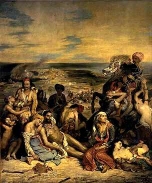
|
Like Lord Byron, the young Delacroix espoused the cause of the Greeks under Turkish oppression. This painting illustrates the Turks' repression of an uprising on the island of Chios in 1822. Delacroix's motives are not solely political however; he was attracted throughout his career to exotic subject matter. |
| Wordsworth wrote poems about leechgathers, the mentally retarded, and poor old men and women--subjects Neoclassical writers had no sympathy for. See Wordsworth's Goody Blake and Harry Gill. Visual artists as well introduced new subjects--peasants, rustic figures, the lowly poor.
| |
|
Jean François Millet (1814-1875)
|
|
|
The Gleaners 1857
|
|
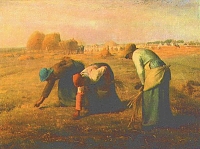
|
Here Millet depicts the lowest of the low--the female peasants who take the leavings of the field after it has been harvested. He rarely glamorizes the poor, showing them in rough homespun and wooden clogs, bent and tired from their labors. Faces usually aren't individualized; these are the anonymous poor. His works were hated by the academic establishment in France: "This is the painting of democrats, of those who don't change their linen....this art disgusts." |
Below are three additional works by Millet, entitled (left to right): Peasant Girls with Brushwood, c. 1852; Woman with a Rake, 1856-57; Peasant Spreading Manure, 1854-55 | ||
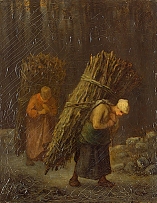 |
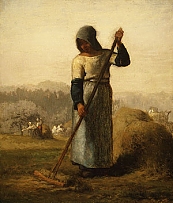 |
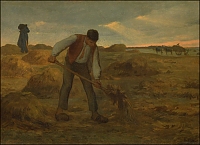 |
|
Francisco Goya (1746-1828)) The Witches' Sabbath, 1820-24 |
 |
| Heroes aren't often depicted in Romantic art but when they are, they are always much larger than life. Recall that Faust is perhaps the most important German Romantic poem--a poem about a man who dared to sell his soul to the Devil. Romantic heroes are often associated with sublime elements as well--alone on a sea, high on a mountain, or in conflict with grand natural forces. | |
|
Eugène Delacroix (1798-1863)
|
|
|
The Lion Hunt 1861
|
|
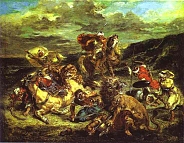
|
Lion hunts among the Moslems would of course be exotic subjects for Europeans. But it is also important that Delacroix pits man against the king of the beasts, against nature at its grandest. These are romantic heroes. |
|
John Martin (1789-1854)
|
|
|
The Bard 1817
|
|
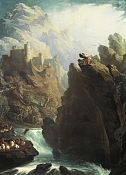
|
The subject is from Thomas Gray's poem The Bard (1755) about the sole surviving bard. Edward I had ordered thaat all the bards be slaughtered; here the last bard stands high on the mountain, cursing the departing armies of the king. |
|
Ford Madox Brown (1821-1893)
|
|
|
Manfred on the Jungfrau 1840-61
|
|
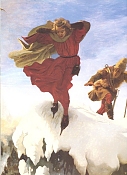
|
Manfred is the titular hero of Lord Byron's poem. A kind of Faust figure, he lives in the Alps, and grandly goes to his death at the end of the poem. Many artists throughout the 19th century depicted this Byronic hero. |
| We end where we began--with art based on a work by Lord Byron (as Delacroix's Death of Sardanapalus was). Instead of classical myth or history, romantic literature often inspired the artists of the day. Instead of the European aristocrats or middle classes depicted in 18th century works, romantic artists broaden the base of representation. | |
All images marked MAS were photographed on location by Mary Ann Sullivan. All other images were scanned from other sources or downloaded from the World Wide Web; they are posted on this password-protected site for educational purposes, at Bluffton College only, under the "fair use" clause of U.S. copyright law.